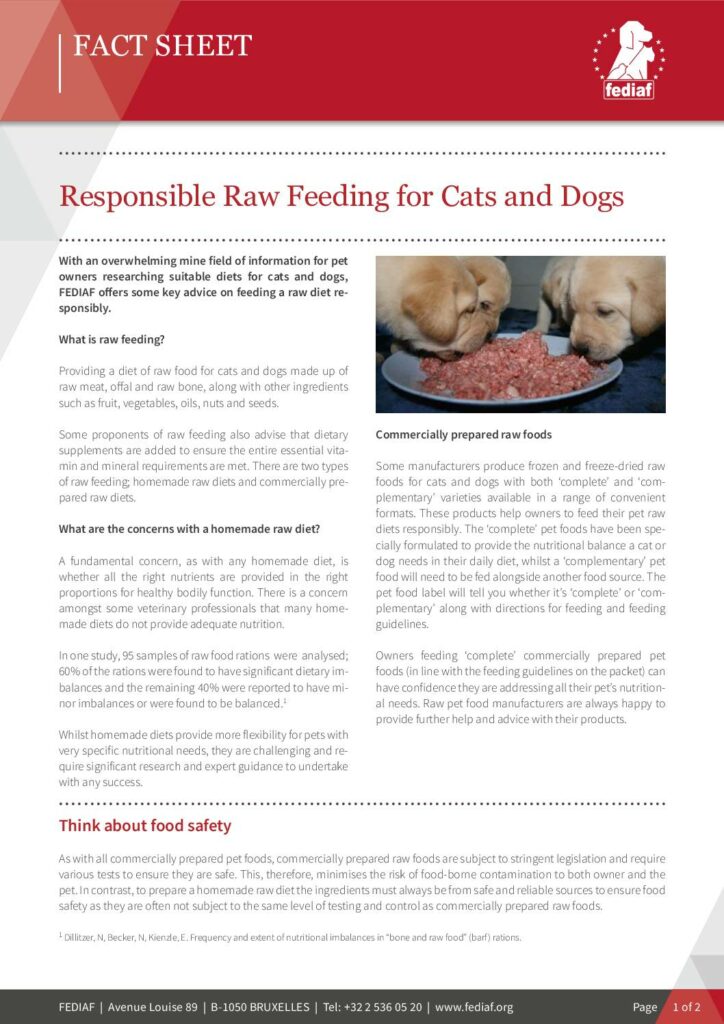With an overwhelming mine field of information for pet owners researching suitable diets for cats and dogs, FEDIAF offers some key advice on feeding a raw diet responsibly.
What is raw feeding?
Providing a diet of raw food for cats and dogs made up of raw meat, offal and raw bone, along with other ingredients such as fruit, vegetables, oils, nuts and seeds.
Some proponents of raw feeding also advise that dietary supplements are added to ensure the entire essential vitamin and mineral requirements are met. There are two types of raw feeding; homemade raw diets and commercially prepared raw diets.
What are the concerns with a homemade raw diet?
A fundamental concern, as with any homemade diet, is whether all the right nutrients are provided in the right proportions for healthy bodily function. There is a concern amongst some veterinary professionals that many homemade diets do not provide adequate nutrition.
In one study, 95 samples of raw food rations were analysed; 60% of the rations were found to have significant dietary imbalances and the remaining 40% were reported to have minor imbalances or were found to be balanced1.
Whilst homemade diets provide more flexibility for pets with very specific nutritional needs, they are challenging and require significant research and expert guidance to undertake with any success.
Commercially prepared raw foods
Some manufacturers produce frozen and freeze-dried raw foods for cats and dogs with both ‘complete’ and ‘complementary’ varieties available in a range of convenient formats. These products help owners to feed their pet raw diets responsibly. The ‘complete’ pet foods have been specially formulated to provide the nutritional balance a cat or dog needs in their daily diet, whilst a ‘complementary’ pet food will need to be fed alongside another food source. The pet food label will tell you whether it’s ‘complete’ or ‘complementary’ along with directions for feeding and feeding guidelines.
Owners feeding ‘complete’ commercially prepared pet foods (in line with the feeding guidelines on the packet) can have confidence they are addressing all their pet’s nutritional needs. Raw pet food manufacturers are always happy to provide further help and advice with their products.
Think about food safety
As with all commercially prepared pet foods, commercially prepared raw foods are subject to stringent legislation and require various tests to ensure they are safe. This, therefore, minimises the risk of food-borne contamination to both owner and the pet. In contrast, to prepare a homemade raw diet the ingredients must always be from safe and reliable sources to ensure food safety as they are often not subject to the same level of testing and control as commercially prepared raw foods.
Hygiene and handling tips
Good hygiene practice is always important and even more so when handling raw meat:
- Purchase products that are in good condition. You should see no visible signs of damage to the packaging such as dents, tears, discolorations, etc.
- Wash your hands with hot water and soap after handling either your pet or their food
- Wash all surfaces that have been in contact with raw meat
- After each use, wash your pet’s bowls, dishes and utensils with soap and hot water, rinse properly and dry before the next use
- Correctly store unsealed containers/open bags to limit any risk of cross contamination
- When storing pet food in the fridge ensure raw products are at the bottom
When buying prepared raw foods you can find the storage instructions on each package.
Considering a change in diet for your pet?
If you are considering a change in diet for your cat or dog, there is a range of reliable sources of advice from your vet and nutritionists. They’ll be able to discuss your pet’s needs, make suitable recommendations and give guidance on how to transition from one food to another.
DEFROSTING RAW PET FOOD TIPS:
- Defrost in a sealed container or your pets bowl and cover it
- Defrost in the fridge or at room temperature for an appropriate time
- Never refreeze
- Never discard the thaw juice as this can contain essential nutrients for your pet
Consult the manufacturer for further information on preparation and storage.
Download the factsheet or click here for more factsheets
1Dillitzer, N, Becker, N, Kienzle, E. Frequency and extent of nutritional imbalances in “bone and raw food” (barf) rations.
